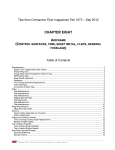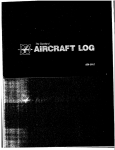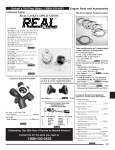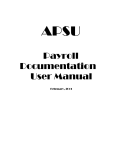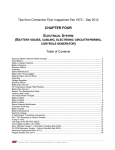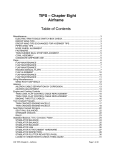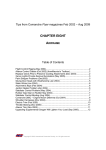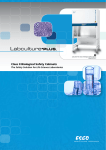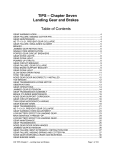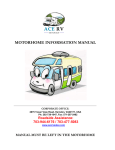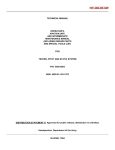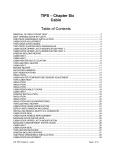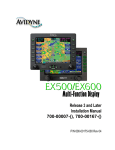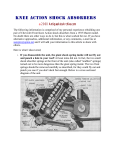Download chapter three fuel system
Transcript
Tips from Comanche Flyer magazines Feb 2002 – Aug 2009 CHAPTER THREE FUEL SYSTEM Table of Contents Fuel Selectors (Feb 2003) ....................................................................................2 Fuel Siphoning Problems (Mar 2003) ...................................................................4 Fuel Selector Problems (Mar 2003) ......................................................................4 Water Contamination in Fuel Filters Is Easily Avoidable (Jan 2004).....................5 Electric Fuel Pumps Problems (Feb 2004) ...........................................................5 Comanche Fuel Tanks Venting (Feb 2004) ..........................................................6 Fuel Tank Dipsticks (Mar 2004) ............................................................................6 Fuel Venting Overboard (Mar 2004) .....................................................................6 Fuel Gauge Sender Unit Gasket Leaks (June 2004) ............................................7 Fuel Odor in the Cabin (Jul 2004) .........................................................................7 Engine Running Rough due to Clogged Fuel Injectors or Spider (Aug 2004) .......8 Electric Fuel Pump Not Pumping (Dec 2004) .......................................................8 Replacing & Relocating the Electric Fuel Pumps – An STC (Apr 2003)................9 Test and Refurbish Procedure For Comanche Fuel Transmitters (Apr 2006)....15 Cancer Within — the Care and Feeding of twin Comanche Fuel Selectors (Feb 2008) ...........................................................................................................17 Fuel Cell Deterioration: A “Fuelish” Tale (Jul 2008) ............................................21 Copyright © 2009, International Comanche Society, Inc. All rights reserved. Fuel Selectors (Feb 2003) Mike Rohrer ICS #13392 This month, I would like to address an old AD that has been around since 1970. AD 70-22-02 covers the "Airborne" fuel selector in our PA 30/39's. I don't know why, but I have found two PA30's and one PA39 that this AD was not complied with. In short, this AD addresses the selector valve. What you are looking for is a roll pin retaining sleeve and safety spring clip to insure a more positive means of securing the fuel selector valve control arm roll pin. Look for the valve model number. This can be found on the manufacturer's plate. Open the door between the front seats where the fuel quick drain is located. Under the model number is another set of numbers and letters. If the number is 4-R, 5-R, etc., and subsequent letter codes, the valve is not affected by this AD. The purpose of this AD is to prevent the possibility of engine fuel starvation resulting from the inability to operate the fuel selector valve due to loss of the control arm roll pin. If your valve is covered by this AD and has not been completed, a red dot should be located on the fuel selector arm immediately adjacent to the retaining sleeve. Piper Service Bulletin 314A also covers this AD. Contact your IA if you have any question, or feel free to contact me. I'll fax you a copy of both. I have received many calls about what to look for during an Annual inspection that is not on the inspection sheet. The things that I find that are missed are actually in the list, but are either ignored or just missed. I know that I have covered several items this past year, but I'll give them all again here; that way they are all together. These are things I have found that are very costly, and if found early, can save a lot of money and grief. 1. Pull fuel plates off (these are the ones that the fuel cap is under). On the twins, remove the cover plates located under the engine nacelle. This requires removing the fairing around the nacelle. Also, remove the wrap-around panel aft of the cowling. With these items removed, you can remove the fuel panels. Under the panels, you will find the fuel sending units. This is where the problem lies. If the gasket is torn or missing (usually the latter), water will get into this area, and the corrosion process will begin. I keep Air Parts of Lockhaven busy repairing the fuel sending units. If your fuel adapter isn't corroded too much (this is the plate the fuel sender is attached to), it might be cleaned up and reused. The problem is that the fuel adapter usually is corroded to the point that pins holes are present. These babies are getting very hard to find. 2. On the twins, again, remove the small plate behind the top engine cowling. Under this is the vacuum filter and cables. I have found many filters so old that when touched they fell apart and into pieces. Also, while you have this plate off, please lube the cables. Now is the time when cables get very stiff and, if forced, will break. What a nightmare this is. Call, and I will sell you the best can of lube that I have found to break free stubborn, stiff cables. I have not found one yet that had to be changed due to this problem. 3. Check tension on all control cables. Did you know that if you have an autopilot and are having problems with the Altitude hold doing a little roller coaster maneuver, most times it is the cable tension? 4. Turn on the autopilot. What you want to do is put opposite pressure on the controls; for example, if the control wheel is turning to the left, hold it and turn to the right. Just slight pressure, and do the same with the pitch. What this does is clean the discs in the clutch pack. You would be surprised if you knew that most autopilots would not disengage if a need rises. Autopilots are made to disengage with a certain amount of force in an emergency. 5. Remove the flap jackscrew and motor assembly. This is very seldom done. I remove it every 500 hours, clean, remove the end cap, and clean out the old grease and install fresh. Copyright © 2009, International Comanche Society, Inc. All rights reserved. 2 6. Remove and clean the fuel injector. This is another item that is missed. I soak them in gun cleaning solution while in an ultrasonic cleaner. If you don't have one, just soak them. 7. With the exhaust removed, spray the welds with some sort of penitrant spray. Let it soak for a while, drink a coke, or if you smoke, have one. The oil will seep through if there is a crack. I have found cracks that were not visible to the eye. Once cleaned up by sandblasting, it showed up. 8. With the exhaust removed, look into the exhaust ports and between the fins located next to the exhaust ports. You will see a fine line that is white, or black. Looks like a carbon crack, for those who have seen those before. Also, I suggest spraying dye penitrant into the exhaust port, and then wait. If it's cracked it will show up between the fins. I have found that cylinders that were overhauled and have about 600 - 800 hours usually have cracks. 9. Remove the gear jackscrew and motor assembly. This is cleaned and lubed just like the flap assembly. 10. Remove the mags, both Slick and Bendix type. Check the condition of the points and adjust per manufacturer specifications. 11. On the PA24's remove the fuel selector valve, clean and lube. This takes a special type of lube. If your IA doesn't have it, call and I will send you some. I can't see buying a can; you will never use it all in your lifetime, or your kids' for that matter. Use it sparingly; if not, it will show up later in your fuel filter. Trust me on this. 12. On the 250's, make sure that the fuel pumps (electrical) are disconnected from each other and checked individually. You will be surprised how many I have found where only one is working. One switch and one C/B for both, and they are both wired together. Good idea, huh? 13. On the 260's, the fuel pump is under the co-pilot's floor, just behind the rudder pedals. For some reason, this panel is not removed. When removed, there usually is a small fuel leak found. 14. Check for fuel stains under the wing close to the wing root area. 15. When changing oil filters, replace the CH48110 with a CH48111, which is longer and holds more. Last month, I covered this item and when I received my issue, I found an error. It should have stated that the CH48110 would bypass around 25 hours not 50 hours. Costs the same, but the CH48111 will last for 50 hours. In addition, remember it is important to change your oil every 3 - 4 months not just every 50 hours, or sooner, if operated in dusty conditions. 16. Remove the Stabilator and check for corrosion. I find this on most of the birds that we inspect. Continue to call me about this. I average about four calls per week on this matter. About one out of five is "clean and corrosion free". 17. Please check this item. It's AD 77-13-21, the notorious gear AD. For some reason, IA's are doing par. (b) every 3 years or 500 hours and not par. (a). They are signing off the AD as complete by doing par (b). Please check your logs and look for the completion of par (a) by inspection. This is not considered complete by merely replacing the BUNGEES. 18. On the twins, remove the fuel filter bowls and clean. If rust or sand is found, you are not draining enough. This will in time cost you a lot of money to overhaul the fuel selector valve, and if you are lucky, it will not kill you or destroy your airplane when the engine shuts down because of fuel starvation. I have found a great place to have the selector valve overhauled. George, down at AirParts of Lockhaven in PA, does a wonderful job and provides a quick turnaround. 19. The fuel bowls on the PA24's are equally important. Copyright © 2009, International Comanche Society, Inc. All rights reserved. 3 20. Check the nose strut where the turning stops are located. The stop should have a shoulder on it and not worn off, and check real close for cracks. The damage is caused from turning the nose gear beyond the stops. Call, and I'll send you the turn limit decal. Fuel Siphoning Problems (Mar 2003) Mike Rohrer ICS #13392 Recently, while investigating a complaint on a PA30 fuel-siphoning problem, I found that the fuel selector was by-passing through. The left aux. tank was leaking into the right main tank. When I removed the fuel bowls for the inspection, I found what I had expected. There was a lot of sand and water in the bowls, and when the fuel selector was removed, I found the check balls were leaking through because of corrosion. The selector could not be overhauled and a "serviceable unit" had to be purchased. Moral of the story - drain, drain, and drain some more. Fuel Selector Problems (Mar 2003) Al Bieck ICS #02171 One of Murphy's laws says: "If it is possible to install a part backwards, someone will do so!" Recently, when I removed the sediment bowl from the strainer assembly (part No. 22312-00) in our "250", I discovered internal leakage through the fuel selector valve (hoof), which I later rectified by installing a new "0 - ring". What concerned me was that the fuel dribbled out of the outlet port above the screen. To make sure it wasn't fuel draining from the line to the boost pumps, I selected a full tank, and, sure enough, fuel streamed out of the wrong port! I then removed the strainer assembly from the aircraft. Confirming what I already knew, the arrows on the casting showed that the outlet port was connected to the fuel selector, and the inlet port (180 degrees opposite) had the 45 degree fitting which connects the line to the fuel pumps and the engine. Turning the unit 180 degrees, and changing the fittings over to where they belong (the right angle fitting receives the line from the fuel selector), corrected the situation. For 18-1/2 years, we flew our Comanche with fuel flowing through the strainer the wrong way, and I feel embarrassed to admit this. But then, we never had leakage through the selector valve resulting in a dribble in the "OFF" position. Neither did I have a reason to take the strainer assembly out. You can't see the arrows on the casting while the unit is installed, except by using a mirror, but I never had reason to be suspicious. We never had a problem, but think we were very lucky. If we had ever gotten a load of dirty fuel, all the crud would have been trapped on top of the screen, possibly blocking it! No wonder we never found anything bad in the samples we have been taking all these years! Also, I never found anything that caught my attention on top of the screen during annual inspections, or I would have caught on. Before we brought our "250" in 1975, it was operated and maintained by a Piper dealer. We never had occasion to remove the strainer from the aircraft, and the dealer probably didn't either. Did the aircraft come like that from the factory, or did the mistake occur during a subsequent repair or modification? We will never know. Most of the early records were lost in a hangar fire long before we bought the aircraft, and the surviving records do not give any clues. Copyright © 2009, International Comanche Society, Inc. All rights reserved. 4 Water Contamination in Fuel Filters Is Easily Avoidable (Jan 2004) Mike Rohrer - ICS #13393 I was just reading an article in the December issue of Flying magazine on a topic that I have written about several times. I guess it still isn’t getting across. We need to take care of these machines so that they will take care of us. In addition, this is one of the reasons that our insurance rates are going up. Did you know that some companies are not insuring Twin Comanches that are older than 1965? And some are not even covering the Comanche 180’s. The Flying article states that a Twin Comanche lost power in both engines and crashed due to ice build-up in the fuel filters. Come on people, there is an AD that covers this and it’s due every 50 hours. It states, “To eliminate water contamination of the aircraft fuel supply” and mandates compliance every 50 hours of operation. This aircraft had not been complied with in 16 calendar months and 234 hours of operation. Basically the AD wants you to remove the filter bowls and check for water every 50 hours. The Owner’s Handbook states auxiliary fuel and tip tank fuel should be used in level flight only. Examination of the wreckage revealed evidence of fuel at the scene with the left fuel selector in the “auxiliary” position and the right selector in the “main” position. The airplane was in cruise flight at 6,000 feet in below zero temperatures. I know that not everyone checks his or her fuel filters, but at least drain the things 20 to 30 seconds for each tank. I go as far as draining them after flight. This way, if any water is trapped when first drained it most likely will be repositioned after flying. I continue to see water in the filter bowls in twins, some so bad that the selector had to be overhauled because of severe corrosion. A sign of corrosion is when you go out to the airplane after it has sat, and when you remove a fuel cap the fuel gushes out and one of your other tanks is low. This is the result of a rusted check valve in the selectors, which does not seat anymore. Therefore, fuel passes through into another tank. So please, for safety sake, drain your tanks. Airplanes get very quiet when the fuel flow stops. It is so easy to drain, so why take the chance? It doesn’t make any sense to me. Electric Fuel Pumps Problems (Feb 2004) Q Occasionally the engine on my 250 sputters and wants to quit after takeoff when I switch off the electric fuel pumps. The pressure indicates it is low when this occurs, but goes back up when I switch the electric pumps back on. Is my engine-driven pump going bad? A The plumbing of the aux. pump on 180s and 250s is configured so that while the aux. pump is on, fuel is not flowing through the engine-driven pump and the fuel in the engine-driven pump rapidly heats. This can result in a vapour lock in the pump and an engine stoppage when the electric pumps fails or is turned off. It is recommended that the aux. pump is checked as part of pre-flight and then not turned on until immediately prior to takeoff. It should be off during the engine run-ups to prove the efficiency of the engine-driven pump. Vapour lock is usually a concern only during the hot summer months. Also, here is some additional information concerning your engine-driven pump. Copyright © 2009, International Comanche Society, Inc. All rights reserved. 5 Most normally aspirated Comanches use a diaphragm type, engine-driven fuel pump. Old age and non-use can cause these pumps to fail. If your electric aux. pumps are not working correctly (i.e. able to supply the correct volume and pressure) you may be faced with an engine failure. (See the TIPs Manual for advice on testing and ensuring correct pressure during maintenance.) Comanche Fuel Tanks Venting (Feb 2004) Q How do the Comanche fuel tanks vent? I have heard there can be problems with the venting system. What are the problems if any? A The fuel caps on Comanches are not vented. A blocked tank vent will therefore result in the fuel cell either not feeding, or else the fuel cell being sucked flat. Tip tanks can be deformed and collapse and rubber bladders will either be lifted upward or the cell will detach from the retainers and collapse from the top. In either case, the fuel quantity indicators will read incorrectly. Comanche vent tubes (mains, aux’s and tips) have proven to be preferred homes for mud wasps. It is a good idea to keep a length of flexible plastic tube in the aircraft and (with the fuel cap off) ensure that you can blow air into the tank. It is a good idea to check the overflow at the same time. I keep a short length of old tachometer cable in my toolbox to run thru through the vents to clear blockage. This is important especially prior to an Atlantic flight. Fuel Tank Dipsticks (Mar 2004) Q The fuel gauges in my Comanche 250 are not very accurate and when I look in the tanks it is very hard to judge how much fuel there is. Lots of times I have a short trip that doesn’t require a lot of fuel, but with four people aboard, I don’t want to fill the tanks to the top. Yet by just looking in the tank, sometimes I’m not certain if there is enough fuel. Is there a way to measure the fuel? A Years ago I made a dipstick for my 250 just to address the very concerns you expressed. I used a piece of white oak (any dense wood will work), and with a tank that I had run empty, I added 5 gallons at a time and measured the result. (See accompanying photos.) One side of the stick is for the mains, the other for the auxiliary tanks. I made the marks with a saw and painted the stick flat black. For 5 and 10 gallons in the aux. tank, the marks are at: • 2 9/16 inches and 4 5/16 inches The main tank markings in 5 gallon increments are: • 2 inches, 3 1/2 inches, 4 5/8 inches, 5 3/4 inches, and 7 1/8 inches. I now use the same stick for my Twin Comanche. Of course the aircraft needs to be level for the readings to be valid. Fuel Venting Overboard (Mar 2004) Q I have a twin Comanche. Occasionally I will find fuel going overboard via the vent line from my right auxiliary tank. It is as though the tank is being overfilled even though it is not. I have been careful to not fill the tank to maximum, and still, sometimes there will be fuel dripping from the overflow after the aircraft has been sitting for some time. Is my airplane haunted? It seems to be manufacturing fuel! What is happening? Copyright © 2009, International Comanche Society, Inc. All rights reserved. 6 A Although you didn’t say so, I assume your twin has tip tanks. The fuel system is designed so that the lines from the tip tank and the aux. tank both feed into a solenoid valve. The switch near the tank selector switches the solenoid valve so the fuel feeds from the tip or the aux. tank. If the o-ring is bad in the solenoid valve, or if there is a bit of debris lodged against the valve seat, fuel will drain from the tip tank to the aux. tank through the solenoid valve since the tip tank is higher. Your aircraft is not “manufacturing” fuel. The fuel is simply transferring from the tip tank to the aux. tank. When the aux. tank cannot hold more than its capacity, the excess vents overboard. You need to remove the solenoid valve for inspection. Both solenoids are located in the cabin against the front of the main spar. Fuel Gauge Sender Unit Gasket Leaks (June 2004) Q When I fill the right auxiliary tank on my twin after landing, I find a blue fuel stain that seems to be coming from a panel behind the tank fill door. What is under there that could be leaking and how do I fix it? A The panel you refer to is where the bladder is installed. It is also the location of the fuel quantity sending unit. The cork gasket on the sending unit tends to dry out after time and, if the tank is full, there can be leakage during climb out. Usually, you can resolve the leak if you remove the sending unit and apply Fuel Lube to both sides of the cork gasket. Fuel Lube is a Vaseline-like substance available from Aircraft Spruce (p/n 09-25300). Also, be sure to apply a sealant to the edges of the cover to keep water out of the cavity. If water gets into the cavity, corrosion can occur on the bolts that retain the bladder and cause leakage around the bladder retaining plate. There is more than one choice for a sealant. One is aviation grade RTV, which is an approved aircraft sealant compound, but you must be very careful when using it, especially on fuel systems. Unlike Fuel Lube, some RTV can harden and become brittle. Small pieces could cause a blockage if they get in your fuel system. An alternative to aviation grade RTV is a non-hardening sealant used by some of our members: Sealube by Ohio Industrial Lubricants. A one-pound can from Aircraft Spruce will last forever. Fuel Odor in the Cabin (Jul 2004) Q I have a 1967 PA-30. There is an occasional fuel smell in the cabin. We have checked all the fuel lines in the cabin along with the fuel selector and the boost pumps. We can’t find the leak. Any ideas? A If there is even a tiny leak in one of the fuel bladders, the fuel smell can migrate to the cabin thru the wing root, and is often especially apparent after landing. The most common place for small holes to develop is in the top of the bladders (main or aux tanks). In this case, the fuel smell is present when the tanks are full, but not when they are down a bit. Another site for fuel leaks is in the fuel sender fittings in the tanks. These may become corroded if the overlying inspection panel has not been correctly sealed, allowing water ingress. Another source of a fuel leak could be the combustion heater. John Regier at Webco reports that they have lately found a couple of cases where the fuel leaks slightly around the valve stem, but only when the valve is being operated. That situation would make the leak difficult to locate. Check that the lines are not reversed to the valve. The valve stem seal should not be pressurized when the valve is “off”, but this will occur if the lines are reversed (as they can be). Copyright © 2009, International Comanche Society, Inc. All rights reserved. 7 While you say that you have checked all the fuel lines, the fittings on these lines can actually leak without any visible evidence of a fuel stain. Someone familiar with them should check them. Do not just tighten them further. This can crack them. Some of these fittings require small o-rings which should be present and in good condition. Engine Running Rough due to Clogged Fuel Injectors or Spider (Aug 2004) Q I have a 1966 260-B Model Comanche. Lately the engine is running a little rough and I have noticed the fuel flow is higher than normal. What do you suppose is causing this? Leaning doesn’t help; it gets worse. A Unlike the earlier carbureted single-engine Comanches, the 1966 and later models have fuelinjected engines and the symptoms you describe are not uncommon. Our panel of technical experts suggests you have at least one blocked injector, or foreign material in the fuel distributor (“spider”), possibly both. As a result, one or more of your cylinders is not receiving proper fuel flow and is running too lean. That is why leaning makes it worse – you are already too lean on one or more cylinders. The fuel flow, which you think is rising, is not doing so. The fuel flow gauge is actually a pressure gauge calibrated in fuel flow units. With an obstruction increasing the back pressure in the fuel system, you have an indicated rise in fuel flow, not an actual rise. While the problem could possibly be isolated with an engine analyzer, it is probably best to clean the entire system. The injectors, the fuel “spider,” and the related lines should be cleaned and the small strainer from the fuel servo should be checked for contamination and corrosion. Another good bit of advice is to have a look at the top of the piston and underside of the valves in the affected cylinder to make sure there is no damage caused by running lean at high power for a prolonged period. One member with a 1966 260B removes and ultrasonic cleans his injectors every 200 hours as a matter of routine maintenance since all the injectors become dirty with use. This can be caused by fuel dye and other additives in the fuel. He says he is amazed at the difference in performance with clean injectors. Electric Fuel Pump Not Pumping (Dec 2004) Q I have replaced two left electric fuel pumps this year; and the third one just failed. Always the left one. One was old, one was new from Weldon, and the last one was overhauled by Aircraft Accessories. The aircraft is hangared in south Florida, and the fuel is sumped every flight. We usually get a teaspoon of water from 6 tanks. We have installed reminder lights for the pumps and do not leave them on except as required. Any suggestion would be greatly appreciated. A We’re sorry to say you may have stumped the experts, but let’s give it a whirl. The fuel pump situation sounds onerous, and the fact it is always the left one that fails does not suggest a quality problem with the pumps, although it doesn’t rule it out. Definitely, the pump manufacturer should be contacted and an inquiry as to the possible causes for pump failures. The answers should give a clue as to where to start looking for the problem. Repetitive pump failure sounds as if the pump may be working too hard. The fact that each failure has involved a different condition pump (i.e. used [old], a new Weldon and now an overhauled one from AA), is puzzling. There may be something else going on. You might check the fuel lines and make sure they are unobstructed. Copyright © 2009, International Comanche Society, Inc. All rights reserved. 8 The pump itself has hardened steel vanes, and if it turns by hand, it is probably okay, but the motor is a different matter. There was a discussion on the Delphi site about the uniqueness of the new motor Weldon uses for the PA-30 pumps. The pump has a tab on the shaft, while the motor has a slot. The end play tolerance between the tab and slot is critical. If, upon assembly, the tab bottoms out on the slot, the motor does not have enough torque to overcome the end play tightness. One fix is to use the standard length motor, make cutouts and bead them in the transverse shear web where the pumps are located. Also, the pressure needs to be set at 25 psi after the pump is installed. There is one report of a series of pump failures, more than six in all, and these were all new Weldon units as supplied by Webco. On disassembly of some of the older units, it was found that the motors seem to run fine but the pumps have apparently seized. When turned by hand, the pumps turn okay and when reassembled they appear to work. However, there is still a problem and the pumps cannot be refitted without overhaul by an approved shop. As this column is written, there has been difficulty getting a response from Weldon on the warranty position. Apparently, with all the pump failures, none have yet been returned to Webco or Aircraft Accessories and they can do nothing for warranty until the pumps come back. It sounds like Catch-22, and until someone sends one of the failed pumps back to be disassembled, a determination cannot be made concerning the failures. Water in the fuel of a hangared plane that is flown somewhat regularly seems strange. It may have nothing to do with the pump failures but nevertheless the fuel caps and lid seals should be checked. Also it should be noted if the water-in-fuel is coming from the left tanks only or distributed among all tanks, left and right. The water in the fuel could also be from your supplier. If you buy your fuel regularly from the same place, you might want to mention your water-in-fuel problem to the supplier and ask if there are any reports from others since it is an unusual condition. Replacing & Relocating the Electric Fuel Pumps – An STC (Apr 2003) Hugh J. Gallagher, Gallant Airmotive Inc. To: FAA I am submitting form 81110-12 for a one-time Supplemental Type Certificate. This alteration replaces and relocates the electric fuel pumps. The electric fuel pumps will be relocated from the right lower aft side of the engine compartment to the right stringer of the gascolator compartment in the belly of the fuselage. In the PA-24-260 design, the electric fuel pump is located in the belly of the fuselage. The fuel System will not be changed in design. Only the location and type of fuel pumps will change. The pumps will be mounted on the right stringer, and the stringer will be reinforced at the mounting location. The pumps (2) will be new solid State type, Facet #40106, 12v, solid State, negative ground, 4-6 p.s.i. max., 30 g.p.h., with the same p.s.i. and g.p.h. as the original Bendix (now Facet) #478360, interrupter type. Relocation of pumps will prevent pumps from heat soaking and possible vaporization of warm fuel causing low fuel pressures during hot weather operations. These pumps are recommended by Rutan Aircraft Factory, Stoddard Hamilton and other aircraft designers. A new fuel line, running parallel to the original fuel supply line, will be extended from the electric fuel pumps in the gascolator compartment, through a new Standard bulkhead fitting at the firewall, and continue to the outlet side of the engine-driven fuel pump. The original fuel supply line will be extended from the firewall directly to the engine- driven fuel pump with a new section of fuel line. All work performed will be in accordance with acceptable methods and practices as per AC43.131A Chapter 1 Section 3 Para. 99, Chapter 14 Section 2 Para. 709, Chapter 11 Section 7 Para. Copyright © 2009, International Comanche Society, Inc. All rights reserved. 9 514, 515, 516, and 519. Weight and balance and equipment list changes will be made, and flight manual Supplements will be entered. PA-24-250, S/N 24-2999, was manufactured in 1962. Piper manufactured PA-24-250 Comanches from 1958 until the model was discontinued at the end of 1964. The PA-24-260 model started production in 1965 and continued until 1972. A significant improvement in the PA-24-280 model was the relocation of the electric fuel pumps from the engine compartment into the fuselage, away from any heat source. Therefore, the alteration I am applying for is an improvement that Piper made on the later PA-24-260 model aircraft and will improve the safety and Performance of the PA-24-250 model aircraft. I am submitting schematics of the PA-24-250 and the PA-24-260 fuel Systems, a drawing of the new fuel System (showing location of pumps, lines and fittings), copies of weight and balance changes, equipment list changes, and flight manual Supplements. Thank you for your time and attention in this matter. Dear Mr. Gallagher: Approval of Fuel Pump Installation Modification in a Piper PA24-250 / Model Aircraft (Serial Number 24-2999) Project No. ST4209LB-A. We have reviewed the data submitted by the above referenced letters from Mr. Michael Ross, the aircraft owner, and find them acceptable. Also, Mr. VanDyke of this office inspected the aircraft Installation at the Palomar Airport (reference 3) and found it to be satisfactory. Therefore, we are issuing Supplemental "type Certificate (STC) SA00198LAtoyou. Also enclosed is a stamped approved copy of your engineering Master Data Report 92024 dated May 13, 1996. This STC is applicable to Piper Aircraft Serial Number 24-2999 only. If at some future date you wish to obtain a multiple (i.e. applicable to more than this one aircraft) STC, you will need to reapply at that time. In accordance with Federal Aviation Regulations §21.3, and as a recipient o this certificate, you are required t| report any failure, malfunction, or defect, except as provided in §21.3(d)J in any product or part manufactured b you or your contracted suppliers, and which you have determined h resulted or could result in an; occurrences listed in §21.3(c). The report should be communicated initially by telephone to the Manager Propulsion Branch, Los Angel Aircraft Certification Office, Phone No.: (310) 627-5241, within 24 hours after it has been determined a fail has occurred and followed up with written notice to the address show: above. FAA Form 8010-4 (malfunction or defect report) or other appropriate format is acceptable in transmitting the required detail. You, as the STC holder, responsible for any design changes necessary to correct unsafe conditions as well as for submitting those design changes to this office for approval. This requirement is contained in §21.99. In addition, you are required to advise this office of any change in address. Also, §21.50 requires that maintenance procedures for continued airworthiness, as applicable to this change in type design, be made available to the Operator at the time the aircraft is returned to Service. By accepting this certificate, you acknowledge that you have read and understand your responsibilities as STC holder. Editor's Note: This is only a portion) of the Information - there is too much to print - For more details on this time STC please contact HQ. Copyright © 2009, International Comanche Society, Inc. All rights reserved. 10 Copyright © 2009, International Comanche Society, Inc. All rights reserved. 11 Copyright © 2009, International Comanche Society, Inc. All rights reserved. 12 Copyright © 2009, International Comanche Society, Inc. All rights reserved. 13 Copyright © 2009, International Comanche Society, Inc. All rights reserved. 14 Test and Refurbish Procedure For Comanche Fuel Transmitters (Apr 2006) Matt Kurke, A&P - ICS #10288 If you are experiencing erroneous fuel quantity indications in your Comanche, this may be of some interest and assistance in the diagnosis and repair of the fuel quantity indicating system. This is not intended to replace the methods found in the service manuals nor to re-hash them; rather it is to offer additional information. And obviously one should refer procedurally to the appropriate manual. You determine if your capabilities include doing this yourself; there isn’t much mystery involved once the system is understood. An error in fuel quantity indication can be caused by an incorrect resistance value being transmitted to the display gauge unit. There can be a few sources for this problem. Checking for poor connections should be your first line of diagnosis, secondary would be a component. One cause of incorrect resistance can be from corrosion where water has leaked into the transmitter area from poor sealing of an access cover. Water collects in the depression where the transmitter unit is mounted – take a look there. This main tank transmitter didn’t survive due to the extensive corrosion. Copyright © 2009, International Comanche Society, Inc. All rights reserved. 15 This wiper button is okay, even with the small spot that has worn. Another cause is internal to the transmitter – a dirty resistance winding (not obvious) inside a fuel transmitter is quite common and easy to check. The internals of the transmitter are simple and diagnosis and repair fairly simple once disassembled. There are cases however where the fuel level transmitter has reached the end of its life, i.e. the wiper button is too worn, broken or missing, or excessive housing corrosion. A full-range test must be 29.6 to 31.3 ohms for all except the Comanche 400 auxiliary transmitters (they require two transmitters). Before getting into the actual dissection of the transmitter, take a moment to consider other possible culprits. On the single models with one gauge display unit, you will find four push-button momentary switches and a rotary selector switch co-located with the fuel tank selector. Any of these electrical components may have developed some resistance which will add to the value from the fuel level transmitter – the result will be erroneous fuel quantity indication. If you have this type of system, put it on the diagnostic check list in addition to the gauge, fuel transmitters, and connections. The work-related portion starts with removing the wing access cover for the suspect transmitter. Obviously, you need to heed all safety precautions when working in this area. If necessary, drain sufficient fuel from the tank to avoid a problem when the transmitter is removed, then remove the transmitter from the plate assembly. To test the transmitter (see single Comanche service manual section 8-10; section 9-15 for twins) connect an ohmmeter between the terminal and the housing and slowly move the float arm from the bottom stop to the top stop. The ohmmeter indicator should steadily move up-scale, without fluctuation, as the float arm is moved upward. No “drop- Copyright © 2009, International Comanche Society, Inc. All rights reserved. 16 outs” or “opens” are allowed. If it isn’t perfect, proceed with the disassembly phase which is not covered in the service manual, although the main subject of this writing. Once you have determined necessity, the disassembly method depends upon the type of transmitter you are investigating; most employ the soldered-rivet method, some a cover with securing tabs (400 aux). After disassembly, you should first examine the wiper button condition. If the wiper button is not serviceable, your choice is a replacement transmitter. If the wiper components pass inspection, then use an ultra-sonic device employing a basic (non-acidic) solution bath to clean the wound-resistor element. The ultra-sonic bath device is a Harbor Freight item; alternatively they can commonly be found in the female’s area of the bathroom. Don’t tell her you used it to clean your fuel injectors! Remember the end result of approximately 0 to 30 ohms is required. The 400 Comanche auxiliary transmitters are 15 ohms each because the aux tanks require two transmitters which are connected in series. Be sure to repeat the test procedure after you have cleaned a transmitter. To mechanically reattach the pieces of the transmitter, try using a compression riveter on copper rivets (I bought them from McMaster-Carr). The rivets will need to be annealed prior to squeezing. If everything is clean with no corrosion, you should be able to solder the rivets to assure a seal (and no fuel leaks). If you’re not interested in purchasing 100-lot quantities, kits are available. The kit includes five sealing washers, one gasket, five SS screws, two copper rivets, two PVC sleeving, one brass nut and washer. And if you don’t like the condition of the wiring in the wing, a few feet of 18-gauge MS22759/16 Tefzel® wire can be used to splice onto the existing inside the wing. The wire kit comes with butt connectors, heat shrink tubing, a grommet, and ring and knife terminals already crimped. If you do decide to take on this task yourself, this is what I suggest for a logbook entry: Removed the fuel level transmitter for (tank position) fuel tank. Cleaned, adjusted, and tested the transmitter. Re-installed this serviceable unit with new gasket, screws, and seals. (Note: You are the judge on this language – Piper doesn’t address “repair” of this component.) Some/all work performed and using methods found in accordance with the Piper Comanche Service Manual 773-516, 9th revision dated August 15, 1998. An operational check was performed and found to be satisfactory. Cancer Within — the Care and Feeding of twin Comanche Fuel Selectors (Feb 2008) Kristin A. Winter, ICS #15964 Much attention has been paid to the Comanche landing gear system and recently the condition of our tail feathers. Another issue peculiar to the Twin Comanches made itself felt in “Maggie,” my own PA-30. The first clue that all was not well in her fuel selectors, was the presence of flecks of material, which I later discovered was rust appearing in the fuel samples. I had seen these before, but was not overly concerned. Even during the 50-hour when I complied with AD 79-12-08 and AD 83-10- 01, I merely cleaned out the strainer bowl and investigated no further. When one of my boost pumps gave up the ghost, I decided to replace both with the newer version STC’d pumps. With everything apart, it seemed a good time to remove the fuel selectors and make a closer examination. I am glad that I did. What I discovered was that the design of the valve body traps moisture that is not drained during normal pre-flight, or even when drained using the mandated procedure which calls for 10-25 seconds of draining per tank. This water had, in turn, caused rust to form in the divider area between the upper and lower chambers of the valve. Fortunately for me, my selectors were not as badly corroded as the one shown in the photograph. Copyright © 2009, International Comanche Society, Inc. All rights reserved. 17 Corroded fuel selector body From the comments of others on the Comanche Flyer forum and on the Delphi forum, numerous other Twin Comanche owners have found rust in their fuel selectors. Based on the obvious design issues regarding the fuel selector itself, it appears that this may be a fleet-wide problem. Operation of the Fuel Selector In normal mode, the fuel selector operates by porting the fuel into the upper chamber of the body. The position of the selector determines which of the ball check valves is pushed open. From the upper chamber, the fuel flows down the center tube, into the stainless steel fuel bowl. The fuel then travels steel fuel bowl. The fuel then travels up through the filter into the lower chamber and up out of the outlet. In the bypass mode, the pressure differential created by a clogged filter will pull down the bypass valve, allowing fuel to flow from the upper chamber, through the four holes, into the top of the lower chamber and through the outlet port. It is easy to tell from the cut-away photo, that the design of the divider between the upper and lower chamber has a tendency to trap droplets of water both above the divider and on the lower side of the divider, between it and the seat of the bypass valve. Sooner or later, the droplets of water will overcome the cadmium plating on the selector body, and rust will form. Copyright © 2009, International Comanche Society, Inc. All rights reserved. 18 In hindsight, it seems that making the body out of cadmium-plated steel was inadequate to withstand the water that was bound to accumulate. The fact that an earlier service bulletin required the replacement of the cadmium-plated bowl, with one made of stainless steel, is evidence that the potential for internal corrosion was not sufficiently taken into account in the design. This occurred after little more than five years in service. The follow-on airworthiness Directives are further testimony to the potentially serious nature of the problem. Besides potentially degrading the fuel selector to the point of being unserviceable, the accumulation of rust has the potential to clog fuel injector nozzles. Rust particles also have the potential to lodge in the seat of the ball check valves, causing leakage and transferring of fuel from one tank to the other. Given the clear airworthiness implications, and the seeming pervasiveness of the problem of corrosion in the Pa-30 fuel selectors, improved maintenance procedures appear to be necessary. Some Suggestions The first step is to recognize the seriousness of the issue in terms of the potential that rust has on degrading the airworthiness of the fuel selector, and hence the aircraft. The other key issue is that these fuel selectors are a dead part as far as being able to replace a fuel selector body, if yours corrodes beyond serviceability, as did the one in the photograph. There may be a few new-old stock units available, but these are limited and likely expensive. Take care of your fuel selectors or lose them. I suspect that many owners are only performing ADs 79-12-08 and 83-10-01 at the annual inspection. This is likely inadequate. I used to be a bit sloppy about draining the fuel bowls before flight. That has changed. In truth, the fuel selectors should be drained after flight. The longer water sits in the valve, the more damage it will do. The two ADs should also be performed religiously at 50-hour intervals, as required. It is probably a good idea to perform the ADs at least once every six months, if the aircraft is not flying frequently. When removing the fuel bowl to clean the filter as required by aD 83-10-01, I go one step further. After removing the fuel filter, I remove the little clip holding the bypass valve spring in position (see photo.) Copyright © 2009, International Comanche Society, Inc. All rights reserved. 19 This allows me to remove the retaining washer, spring, and the bypass valve itself. Then I place a pail or other catch basin under the selectors and get into the aircraft. By switching the selector from OFF to MAIN, the AUX, and the Crossfeed, for each tank, I drain fuel through the bypass, as well as the normal pathway. This, I hope, will help flush some of the water droplets which seem to accumulate above the divider between the upper and lower chambers and the water trapped between the bypass valve and underside of the divider. I have not figured out how to test this technique, so I don’t know if it offers significant benefit. At least the effort is very modest. It is likely that as further time passes, more of these selector bodies will become unserviceable. The day may come where no serviceable replacement is available. The solution would be to design and gain approval for a replacement body made of stainless steel. Once the Comanche community has addressed the horn issue, the Twin Comanche fuel selectors may merit our attention. Regulatory Requirements ADs 79-12-08 and 83-10-01 address the condition of the fuel selector. These are recurrent ADs. They are required at a minimum of 50-hour intervals, and portions of AD 79-12-08 are required as part of routine operations. AD 79-12-08 incorporates Piper Service Letter 851. It addresses two issues. The first, addressed in Part A of SL 851, deals with seal leakage which can cause fuel to shift from tank to tank or lead to a certain amount of air being pulled in to the fuel line if the tank with the leaky port, happens to be empty. Compliance involves positioning the fuel selector valve to off, and checking to see if the valve continues to drip fuel. Compliance with Part A is required every 50 hours. Part B of SL 851, concerns ensuring that any water is eliminated from the fuel system. The procedure specified in Part B has been incorporated into the updated pilot’s manuals. AD 79-1208 requires draining the sumps through the required procedure, if the aircraft has been exposed to freezing temperatures. This means that if you are flying at an altitude that is below the freezing level, the pilot is required by the AD to drain the sumps before the first flight of the day and after refueling. AD 83-10-01 concerns solid contamination in the fuel, by requiring that the fuel filter be cleaned every 50 hours. Copyright © 2009, International Comanche Society, Inc. All rights reserved. 20 Fuel Cell Deterioration: A “Fuelish” Tale (Jul 2008) Don Ostergard, ICS #3263 Our sturdy bird was recently in for its annual. It is a 1959 PA24-250, which makes it 49 years old. We’ve owned it since 1979 — almost 29 years. It is equipped with the standard (for 1959) two 30 U.S. gallon inboard fuel bladders (some folks call them fuel cells). It also has tip tanks that are of no consequence to the following story. Back in 1988 (20 years ago), we became aware of fuel stains under the inboard area of the wings, as well as the occasional whiff of gasoline fumes in the cockpit. Clearly, the main fuel cells were beginning to seep. So, as the logbook entry states, out they went for overhaul at a repair shop that is licensed to repair/overhaul fuel cells. We were in on the decision and remember it well. Now, it is always the top surface of a fuel cell that dries out and starts leaking. When a fuel cell is sent out to the repair facility for overhaul, they will pressure it up, find the leaks, then turn the cell inside out and cement patches onto the offending spots, pressure test again and return the fuel cell to service. In most cases, there will be several patches involved, along with multiple retests, before the last leak is repaired. The bladders were overhauled, replaced in the wings, and gave nearly 20 years of excellent service. There was never a trace of fuel seepage and never a whiff of gas fumes in the cabin. Shortly after the Comanche was introduced 50 years ago, there were apparently some instances of the fuel vent tubes (which are located on the underside of the wings and face forward) becoming blocked with ice when the aircraft was being operated in icing conditions. With no opportunity to vent the bladder to compensate for the fuel being consumed in flight, the bladder would, of course, collapse upon itself, popping some or all of the snaps that were holding it in place. Service Bulletin #190 (June, 1960) and AD 68-13-03 (1968) address this issue. The Service Bulletin is a simple fix that largely removes the risk of the vent plugging when flying in icing conditions. It is likely that almost every Comanche in existence has had this procedure performed on it. To comply with the later AD, one may either install a different fuel venting system (very expensive, high labour component) or simply check the vent tubes for obstructions and inspect the fuel bladder internally every 100 flight hours. This inspection, to reduce it into the simplest terms, consists primarily of inserting a small mirror through the fuel filler neck and shining a flashlight into the bladder to see if the bladder has collapsed/unsnapped. It takes about five minutes per tank to perform this inspection. The sturdy bird does not have the modified fuel vent, so it undergoes the 100-hour inspection. No big deal. Our AME (we call them Aircraft Maintenance Engineers here in Canada, they’re known as A&Ps in the U.S.) has done it at least 28 times. One could perform the inspection oneself every time the plane is refuelled, if one wished. It might actually not be all that bad an idea. In the course of this latest inspection, our AME discovered a big patch hanging down from the top of one fuel cell. Then he checked the other fuel cell. Same thing! (We are not making this up.) So he removed the oval access plates, reached his hand inside and ran it inside the top of each fuel cell. Imagine his surprise when patches started falling off in his hand! Why these patches all choose to loosen up, more or less simultaneously, after 19-plus years is somewhat of a mystery, but is beside the point. It takes very little imagination to visualize one of these patches falling off and blocking the fuel outlet — one’s bones go soft just thinking about it. Copyright © 2009, International Comanche Society, Inc. All rights reserved. 21 The photo shows one of the fuel cells and the fifteen patches that it contained. There were patches on the patches! The other fuel cell wasn’t any different. We must stress that the repairs to these fuel cells were in full compliance with approved, recognized practices. Everything was perfectly legal. Summary To recap: The plane was built in 1959; we bought the plane in 1979. The fuel cells may have been overhauled sometime during the period 1959-1979; we haven’t bothered to check the old records. We do know that they were overhauled once between 1979 and the present, namely in 1986. We are fanatic about maintenance. There have been no maintenance shortcuts taken with this plane in the past 29 years. There has never been anything but avgas in the tanks. If this happened to us, it can happen to anyone. Copyright © 2009, International Comanche Society, Inc. All rights reserved. 22 What Can We Learn From This? 1. Be sure to check those fuel cells regularly. You can do it yourself in a few minutes using a flashlight and a mirror. If our plane had the new style vents installed, there would have been no requirement to check the inside of the fuel cells; ever. Not having changed the vents may have saved our lives. Imagine the irony of that! 2. Always have half-an-hour of gas in a tank that you can go back to. 3. Don’t ever ignore basic maintenance. That $100,000 radio stack won’t save your hide if the prop stops turning. It is our understanding that we could legally have sent these old fuels cells out for overhaul, again. Did we? Absolutely not! We destroyed them and bought new ones. Copyright © 2009, International Comanche Society, Inc. All rights reserved. 23























